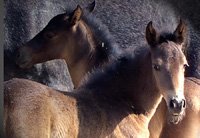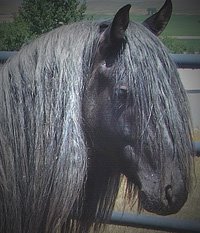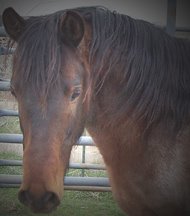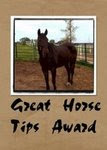I’m unusually conservative when it comes to introducing the canter with my horses. It always interests me to see other trainers start a green horse cantering on its tenth or eleventh ride. What, I wonder, is the hurry? No doubt they have their reasons, but I prefer to wait up to a year before asking my greenies to move up from the trot.
I have my reasons, too. Almost as soon as my horses are under saddle, I move their training sessions onto the trail. With endurance as a goal, this makes perfect sense – why not start in on that long, slow distance base while establishing the basics? But, out on the road or trail, without the security of fences or company, mental steadiness is paramount. I’ve no interest in injecting a shot of speed-induced adrenaline to the proceedings. Besides, a young endurance horse can gain nothing but benefit from many months and miles of trotting, trotting, and trotting some more.
That said, the time for cantering does come – and Consolation has arrived. I mentioned in my last post that I’ve added significantly more cantering to her workouts as a means of increasing her fitness and exploring ways to increase her average pace. As with most new requests I make of Consolation, convincing her to canter has required extensive conversation.
We began last year at Owyhee Canyonlands, near the end of her first 50-mile race. I believe in making the right answer easy for my horse to find, and it seemed wise to take advantage of both the pull of the horse ahead (to encourage speed) and the weight of miles behind (to minimize, erm, overzealous expressions of enthusiasm). Sure enough, we got in a few stretches of buck-free cantering – a perfect introduction to the gait.
This spring, I needed to move Consolation’s canter to the conditioning trail. We started with extended canters during her liberty sessions in the round corral, boosting her fitness and balance for the gait. Next, I began asking for a canter under saddle. Because she is prone to slow motion but not to racing home, I found it most appropriate to do so during the latter half of our rides, when we were pointed homeward.
At first, a few strides was plenty. Unsure of her own balance and particularly my desires (a possible argument for introducing the canter earlier), Consolation required substantial urging to continue cantering. After a few sessions, she got the idea, but keeping her in the gait remained difficult due to her general distaste for expending more effort than she deems necessary.
We kept at it, though, and within a few weeks, we'd developed a language that seemed to build her confidence and enthusiasm. I asked her to canter only when she felt energetic and positive, and used as a pre-cue a verbal, "You wanna?"
Depending on her response -- slowed trot or gathered quarters -- I either desisted or proceeded with the standard canter request. Seat, leg, rein. Voila!
[Digression: I thought long and hard about whether it was a good idea to give Consolation a say in the matter. After all, aren't our horses supposed to obey our leadership, immediately, at all times? Well now, that depends. In matters of safety, yes. But in our athletic endeavors, Consolation is a full partner and responds best to mutual respect.]
Sure enough, it wasn't long before she discovered the fun inherent in speed. Now it was her fitness level, rather than her mind, that held her back. She’d falter after a quarter- or half-mile of cantering, dropping to a walk with such abruptness that my seat – already much enhanced by the experience of riding this mare – made additional, rapid improvements.
Still, we kept on. I concentrated on timing my requests so that I asked her to walk or trot moments before she made the decision on her own. I tried never to let her get winded or weary, because if cantering became work instead of fun, we’d find ourselves locked in an everlasting battle.
Finally, the old magic happened. It always does.
After a long series of incremental improvements, Consolation made her great leap into achievement: Two days ago, she cantered over half of a 14-mile ride. She volunteered to canter. She wanted to canter. She asked to carry on even when I directed her to stop. We discussed the matter as partners, co-conspirators there on the sunlit, windblown track, and reached a happy compromise that cut twenty minutes off our usual time.
That’s my girl.
_________________________________________________________
Subscribe to The Barb Wire
Thursday, May 27, 2010
Subscribe to:
Post Comments (Atom)









3 comments:
Raven was race trained, and prone to expending more energy than necessary. The conversations were always about walking instead of trotting, and trotting instead of galloping. Whenever I felt she needed to blow off some steam I'd take her down to the long, flat turf and ask "you wanna go?". She always did.
I love your philosophy regarding this cantering issue. It is nice to know that you regard your horse as a full partner. Bravo....and beautifully written.
I have found that the approach you are using works best with this breed of horse in general. I find them to be tempermentally between a mule and a horse. They MUST be full parnters regardless of what kind of riding you do or they simply will get fed up with you and quit working (or start evading and refusing). That's what I've noticed anyway.
Post a Comment